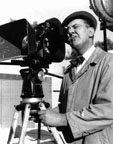|
One of my favourite places here in London is the huge HMV shop in Oxford Street with its thousands of CDs, records, books and films that always leave me penniless after every visit.
The biggest temptation is the DVD section of World Cinema with all these wonderfully remastered versions of Classic Cinema.
The other day I fell onto a film I had almost forgotten, "Les Vacances de Monsieur Hulot" by Jacques Tati and it has indeed lost nothing of its charm and fascination.
Monsieur Hulot was the European counter piece to Buster Keaton, a blank-faced comic cipher garbed in a crumbled raincoat and ill-fitting trousers, an ever-present pipe muffling any words he may say, an umbrella clutched in indecisive hands.
Throwing himself into everything from a tennis match to a fancy dress party, Hulot was an accident personified. Amiable and courteous, he was a gentle lunatic, unaware that his enthusiasms are forging a chain of disaster. A major influence on comedians from Terry Jones to Dom Joly, and particularly Rowan Atkinson's Mr Bean, Tati's legacy remains still strong today
Born Jacques Tatischeff October 9, 1908, in Le Pecq, France, he first gained notice as a professional rugby player before beginning his performing career in area music halls as a pantomime and impersonator.  Tati mounted his first film short, the comedy "Oscar, Champion du Tennis", in 1931, but never saw the project through to its completion. His subsequent early work, including 1934's "On Demande une Brute", 1935's "Gai Dimanche", and 1936's "Soigne ton Gauche", presaged his later features in their fascination with natural and mechanical sounds. Tati mounted his first film short, the comedy "Oscar, Champion du Tennis", in 1931, but never saw the project through to its completion. His subsequent early work, including 1934's "On Demande une Brute", 1935's "Gai Dimanche", and 1936's "Soigne ton Gauche", presaged his later features in their fascination with natural and mechanical sounds.
The outbreak of World War II, which he spent stationed in the village of Sainte-Severe-sur-Indre, brought Tati's career to a temporary halt, and after completing the 1938 short "Retour a la terre", he did not appear before the camera again prior to Claude Autant-Lara's 1945 comedy "Sylvie et le fantome".
In his short film, "L'Ecole de Facteurs" (1947), Tati created the character of Francois the postman, a character he would play himself in his first self-directed feature, "Jour de Fete" (1948). "Jour" used the riffling gag structure Tati would explore more fully in his later features, plus creative sound as a source for gags.
Unhappy with the Francois character, Tati sought a persona with a more universal appeal. With Monsieur Hulot, Tati found his cosmic archetype: a zero who creates comic anarchy in his wake.
Hulot had no purpose except to ignite the gag machinery. He was never the centre of a gag sequence and frequently disappeared from the gag situation once the perpetual motion machine takes hold. The result created a tension for audience expectations: would the punch line continue to be prolonged or simply demolished? Tati did not allow his audience to identify with the main character in the scene; as a result, the subject of the shot became everything that appeared within the frame.
A Tati film is characterized by a tangled texture that requires many viewings to unravel.
In "Mr.Hulot's Holiday", Tati applied Hulot to the gag structures of "Jour de Fete." "Mon Oncle" dealt with the tension between Hulot's old world sensibilities and the new world of modern mechanization and consumerism. "Playtime", Tati's masterpiece, released in 70mm and stereophonic sound, examined the disappearance of humanity within the maze-like confines of post-industrial society.
"Trafic" finally portrayed the anthropomorphism of automobiles and the mechanization of human beings.
With each film that followed the ambition and complexity of Tati's comedic style grew. He committed himself fully to a rigid filmmaking approach that became increasingly apparent onscreen. Tati pioneered a comedic process that relied almost exclusively on visual elements infused with ambient sound; dialogue was almost entirely abandoned as a means to convey humour. Presented in an often uniform and unobtrusive fashion with the camera doing very little work at all, Tati's subsequent feature films appear as little more than a collection of frieze-like sketches strung together for cheap laughs. However, this surface simplicity belies a complex, multi-layered process of preparation and choreography that Tati stuck to meticulously.
In his stumbling journeys through the modern world, Hulot became the perfect vessel for his creator's musings on the nature of humanity in relation to the consumerism and mechanization of contemporary society; the persona also allowed Tati to subvert the rules of film comedy by toying with the notion of the punch line, a payoff often delayed or entirely ignored to further play against viewer expectation. The cumulative effect was almost labyrinthine in its comic possibilities, and indeed, Tati's films grew so complex that only repeated viewings allowed his work to achieve its full effect. The intricacy of the Hulot films took Tati years to achieve, and as a result the second film in the series, Mon Oncle, did not appear until 1958.
This complexity was Tati's commercial undoing. The nine-year gap between "Mon Oncle" and "Playtime" crippled the momentum of his career, and after the extravagances of "Playtime," Tati never recovered financially. When "Trafic" was released, it seemed a throwback to his films before "Playtime" and was a financial failure.
In 1974 Tati released Parade, a low-budget collection of slapstick gags and pantomime, which he shot on video; it was unfortunately to be his last completed work before he died November 5, 1982.
He was the master of modern film comedy, a creator of complex comic structures in which gag constructions and audience expectations became pawns on his cinematic board and in re-interpreting some of comedy's oldest and purest techniques, filtering them through a distinctly modernist framework, Tati became an influential guiding light for the generations of comedians and filmmakers that followed.
|